John Tinnell, University of Florida
Enculturation: http://www.enculturation.net/all-the-worlds-a-link
(Published December 14, 2011)
Since Sputnik and the satellites, the planet is enclosed in a manmade [sic] environment that ends "Nature" and turns the globe into a repertory theater to be programmed.
—Marshall McLuhan, From Cliché to Archetype
Download video: MP4 format | Ogg format
Technical Note
Enculturation's embedded videos are best viewed in Chrome, Safari, or Firefox. We have included downloadable versions via the links above for those who experience problems with the embedded version.
Marshall McLuhan’s conception of the global village has become one of the most cliché descriptors for commentators celebrating the World Wide Web. In his later writings, however, McLuhan himself began to drop the term in favor of what looks like only a slight revision: the global theater. This move from global village to global theater dispenses with the former term’s insistence on secondary orality and tribal collectivity. Although the notion of global theater is underdeveloped by comparison (by McLuhan and his commentators alike), some basic characteristics can be traced. In a brief 1974 essay, McLuhan, riffing off the few passages in From Cliché to Archetype that introduce the term, reiterates his belief that global theater became a defining condition of human existence on October 17, 1957—the moment Sputnik was launched into orbit. He refers to this moment as “perhaps the largest conceivable revolution in information,” and goes on to unpack its significance in terms of performance and surveillance (“Global Theater” 49). Encapsulated by satellites, vast stretches of the Earth’s surface quickly became a potential stage for live broadcasting, videoconferencing, and other electronics-enabled forms of (mass) performance.
Always one to emphasize the existential implications of any technological innovation, McLuhan claims that “the result of living inside of a proscenium arch of satellites is that the young now accept the public spaces of the earth as role-playing areas” (From Cliché 10). That is, widespread televisual applications of satellite technology cultivated a tele-performative space, which, in mapping over whatever established spatial conventions previously structured one’s experience of a place, added an awareness that whatever took place in the presence of various electronic recording devices could be broadcast to and seen by large audiences all across the world, in real time and for all time. This awareness becomes a force of enculturation; one does not need to possess a video camera to be ontologically affected by the cultural (f)act of televisual recording and worldwide broadcasting. Moreover, with the ability to broadcast the sights and sounds of such tele-performative spaces comes a general susceptibility to surveillance. The same satellite that enables you to communicate also affords others the potential to track your activity.
As a discipline, composition studies—born during the Sputnik movement but launched in 1963—has made little effort to explicitly engage with the rhetorical significance of satellites to which McLuhan alluded in his writing on global theater. With the recent spread of smartphones and the very recent emergence of a mobile app genre called “world browsers,” however, the condition of global theater bears tremendous relevance for those studying the bourgeoning writing ecologies of wireless, mobile platforms. With the arrival of such apps, the global positioning system (GPS) is becoming the basis for a new way of navigating writing and moving through information. While every writing technology grants a range of rhetorical affordances to writers, the cultural status of a given technology significantly impacts how people are likely to engage with it. Likewise, our possible relationships with any given technology emerge from the various ways we work and play with that technology; rhetorics and poetics are not technologically determined, even though technologies and other vibrant matter certainly massage, constrain, and variously enable invention processes.
Before smartphones and tablets reached a mass market, many of us only engaged GPS and other location-based systems as a means to help us navigate from place to place. In the context of this popular usage, the GPS was hardly considered a writing technology, as common transportation applications generate text only at the level of addresses and directions. A Google search for “GPS” suggests our societal inability to see the forest from the trees; the top results are links to purchase so-called GPS devices—those familiar navigational aids we keep in our vehicles give us access to the GPS but they are not actually themselves the GPS. Strictly speaking, the GPS is a system of 24 satellites launched by the U.S. Department of Defense, which became fully operative and available to civilians in the mid 1990s. The “GPS” that we have in our cars is only one application that makes use of the GPS proper. With the rise of mobile world browsers, we are witnessing the start of a McLuhanian reversal of the GPS headed toward new applications concerned principally with the location-based, object-oriented production and circulation of writing, media, and information. Another striking aspect of world browsers is the way in which they establish a new constellation among a diverse array of media (e.g., cell phones, search engines, Web 2.0 platforms, locative media, and augmented reality) that were, for the most part, previously being developed along separate planes. For this reason, the “media ecology” vein of McLuhan’s work—out of which his theoretical insights on global theater arise—provides apt methodological guidance for the rhetorical study of world browsers.
Smartphones as Search Engines: World Browsers, Internet Vision, Spatial Contestation
Since its invention, the telephone has been almost entirely associated with speech and the sense of hearing. According to McLuhan, phones make for an “extension of the ear and voice that is a kind of extra sensory perception” (Understanding Media 8). As cell phones began to eclipse landline phones, writing scholars generally continued to examine cell phones for their importance as a new medium of oral rhetoric. Jenny Edbauer Rice forwards the thesis that the widespread use of cell phones in public settings creates a new kind of collective experience defined by acts of overhearing. As we all know, cell phones enable people to carry on intimate conversations in public places, wherein anyone nearby can hear—whether s/he wants to or not—the speech directed at but not limited to the person(s) at the other end of the line. And so the person speaking into the cell phone (unwittingly) makes palpable the intimacy of an otherwise private conversation, while people near the speaker become privy to “private” remarks as the fragments of a closed dialogue spill out into an otherwise public space. Edbauer Rice calls this condition “public intimacy.” Resembling McLuhan, she asserts that the ramped use of cell phones in public leads to “a technologization of another kind of hearing” and a “sociality that is neither public nor private” (96).
With the cellular market now leaning in the direction of smartphones, however, the visual and the kinetic assume a greater role in mobile communication. Smartphones introduce into (the phonocentric discourse on) mobile platforms a plethora of rhetorical operations, far beyond text messaging, that are not dependent on (and in some cases completely devoid of) speech. With these rhetorical operations in mind, Paul Levinson observes that “new new media on smartphones have an advantage over cellphones in not disturbing anyone in the vicinity” (190). Of course, speech is not altogether discarded, especially in the case of smartphones that come equipped with speech-to-text software. But instead of remaining a medium of secondary orality, the popular usage of new mobile phone-computers often sidesteps the dominance of ear and voice in favor of eye and touch. In terms of McLuhan’s tetrad, the orality of cell phones becomes obsolesced by the visual dimension of smartphones, or at the very least, oral interfacing becomes a secondary option that is employed less frequently and less impulsively than visual-tactile interfacing.
In addition to considering the cultural and rhetorical implications of aural encounters with mobile phones, we must approach the coming encounters with smartphones (and tablets) on a visual basis. To extrapolate from both McLuhan’s and Edbauer Rice’s writing, mobile world browsers establishes the technological conditions for a new kind of seeing, which may result not in the overt growth of public intimacy so much as the subtle spread of visual epistemology. Like infrared goggles enable night vision, mobile world browsers make possible a way of seeing that we might call Internet vision—seeing the world through the lens of an immense range of Web writing/media that has been geotagged to the places we inhabit. I use the term visual epistemology here to stress the implications of this Internet vision on human cognition and subjectivity; in particular, the rhetorical practices enabled by world browsers are clear manifestations of distributed cognition in action. A pervasive continuum links imaging and ideation.
Explained at the most basic level, world browsers will be to smartphones what Web browsers have been to desktops and laptops. While smartphones still repackage Web browsers (i.e., the software of the old medium), free world browsing apps (e.g., Wikitude, Layar, Cyclopedia, junaio, Argon, TagWhat, etc.) utilize the camera view of smartphones to create a unique visual-tactile interface (Figure 1), which blends a person’s gaze of the physical environment with texts, graphics, and other media files that have been “geotagged” to very specific coordinates on the Earth’s surface.
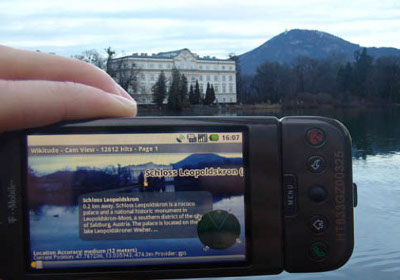
Figure 1: Early iteration of Wikitude World Browser interface
In more theoretical terms, world browsers make possible an immense extension of arche-writing, which, according to Sharon Crowley (commenting on Jacques Derrida), conceives writing broadly as “human in-scription on the world’s surface” (4). In branching out from the global village of the Web into the global theater of world browsers, the virtual space of inscription becomes precisely linked with the world’s surface. Of course, writing upon the world’s surface is nothing new, but prior modes of inscription such as carving or graffiti are both invasive and limited—you cannot (legally) write via graffiti on the gallery walls of the Museum of Modern Art, but you can easily do so via world browsers.
Furthermore, much of the novelty and theoretical-pedagogical importance of world browsers lies in the fact that they graft the manipulability and hyper-circulatory conditions of digital writing networks onto one’s ability to inscribe the world’s surface, as distinct from the strictly computational surface of desktops and laptops, which are “plugged in” to Web and other programs but do not interface directly with the world’s surface. Whereas McLuhan’s writing on global theater tends to embrace the world’s surface as a transmittable stage, the world’s surface also, if not primarily, acts as a hypertextual link in the new global theater of mobile world browsers. If we also factor in Eric McLuhan’s later analogy—that teleconferencing is to global theater what radio is to the global village—it becomes clear that the notion of staging is what attracts both McLuhans to the word theater. In the global theater described by both Eric and Marshall, the world serves as a stage for tele-performance, and because virtually any space on Earth can serve as a backdrop for live footage, people live with the awareness that they may become “actors” in this footage at any given moment—intentionally or not. Without dispensing with the staging aspect so central to both McLuhans’ insights, world browsers condition the possibility for almost anything in the world to function as a virtual-actual link, a dynamic site of intersection between digital information and physical place—both of which are constantly changing and able to make those changes perceptible to us in real-time. Through a radicalization of the link, the global theater of world browsers multiplies the stages on which media content and online networks can perform.
Given the sociospatial effects of talking on cell phones in public, we should already begin to ask how mobile world browsers (among other visually-oriented smartphone/tablet apps) complicate the conditions for our experience in public locations. Nedra Reynolds, whose insights on cell phones are the building blocks of Edbauer Rice’s argument, turns to cultural geography to understand the spaces and places of everyday life as sites of/for cultural production. Reynold’s treatment of Leeds’s Hyde Park neighborhood as a contested place foreshadows the contestations potential to the global theater of world browsers. Drawing from her “students’ accounts of their experiences in and reactions to areas like Hyde Park,” Reynolds infers that spatial contestation is the result of conflicting attitudes with which people regard especially hybrid, diverse, or multi-purpose places (100). Christian Weisser’s study of public writing argues that contestation, as opposed to consensus, is vital to a thriving, democratic public sphere. In fact, Weisser champions theories of the public sphere that acknowledge ongoing dissent within and among alternative discourse communities—theories that run counter to the utilitarian, if not naïve aim “to simulate the fictive coherence and transparency of a public sphere that is not one” (Hansen cited in Weisser 77). Futhermore, these public sphere theorists (especially Oskar Negt and Alexander Kluge) insist on “the creation of new discursive forms in order to legitimize emerging counterpublics,” in contrast to mass media institutions, most of which seem bent on simulating a unified public: the public, public opinion, the American people, etc. (Weisser 79). Given the rapid increase in access to location-based, augmented reality technologies conditioned by the spread of smartphones, as well as the relative ease with which anyone possessing basic computer skills can now contribute content to world browsing platforms, mobile world browsers hold the potential to become a go-to medium for subaltern counterpublics looking to contest popular, corporate, state, or otherwise dominant discourses. Within the virtual-actual domain of world browsing networks, any space can become the place of any number of geotagged compositions (i.e., layers), which may very well map onto a location various conflicting attitudes about that location.
Groups such as the Occupy movement1 have just begun using world browsers as a political medium; nevertheless, for the purpose of indicating the changing stakes of sociospatial contestation wrought by world browsing, a more commonplace example will suffice. For instance, world browser apps such as Wikitude and Layar—as well as the recently released Yelp Mobile app—can be arranged to show (links to) customer reviews of local businesses and restaurants from Yelp.com in their camera-view interface whenever someone points his or her smartphone at such establishments.
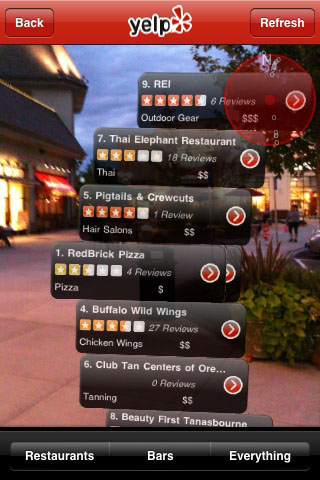
Figure 2: Yelp Mobile interface
Anyone who uses these apps for this purpose will therefore see customer reviews in approximately the same instant that they see the architecture of the building, the company’s logo, the employees, etc. User-generated comments and reviews that have long been a mainstay of Web 2.0 activities suddenly appear at the brick and mortar scene of consumer decisions. Obviously, businesses know the importance of this scene as many routinely spend thousands, even millions of dollars to craft customers’ first impressions and overall brand experiences. Now, for better or worse, indignant consumers can frame corporate imagery in whatever way they see fit. User contributed layers on a world browsing platform are not (yet) punishable like graffiti, and they are not relegated to the comparatively stationary, often socially isolated screens of laptops and desktops. Reviews and commentaries that are literally situated at the scene of consumer decision stand a far greater chance of effecting someone’s way of seeing and understanding particular businesses, such that many corporations may enjoy much less of a monopoly over how their brand is presented. Suffice it to say that this facet of world browsing—which is, with a bit of imagination, extensible to many more genres than just restaurant reviews—hints at promising paths for intervening in rhetorical ecologies deemed urgent by activist writing pedagogies concerned with the critique of globalization, advertizing, and consumer capitalism.
While such contestation between consumer and corporation marks a simple, yet strong, indication of the sociospatial importance of world browsers, the rhetorical activity occurring on this new medium extends beyond the geo-delivery of already existing Web content. Some of the most innovative, born-mobile projects to date have been created by visual artists2 who “display” (i.e., geotag) their work in and around major art museums, doing so without consent from these institutions. In the fall of 2010, a group of artists associated with the Conflux Festival on psychogeography staged an “augmented reality art invasion” at the MoMA NYC. The exhibition, which bypassed the museum’s curators, included a wide range of digital works appearing (for smartphone users) in the same gallery spaces as the physical, curated exhibits. In some cases, the digital works graft onto pieces from the MoMA’s collections (in the tradition of appropriation art), while others take a more conceptual or performance-based approach, such as Mark Skwarek’s piece (Figure 4) that situates author Bruce Sterling’s avatar in the MoMA lobby and includes a thought bubble that broadcasts a live feed from Sterling’s Twitter account.
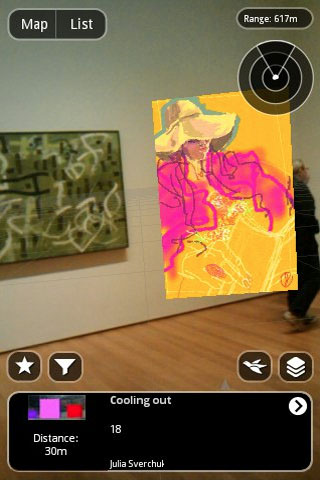
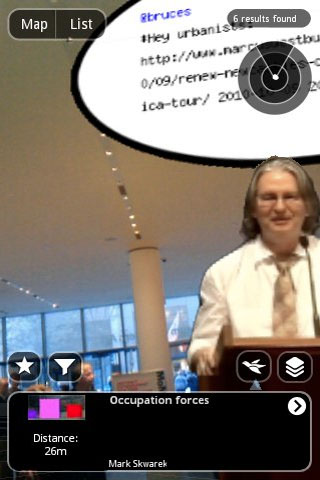
Figures 3-4: “We AR in MoMA” augmented reality exhibition
In addition to transforming the conditions under which the museum’s exhibitions are normally displayed, the invasion-exhibit—which the MoMA staff actually came to embrace—raises serious questions concerning the future of cultural institutions. How does the space of museums change now that virtually any digital works can be virtually exhibited within its walls? What becomes of our relations to exhibited artworks when user-generated commentary is seen alongside the expository text panels that traditionally accompany professionally curated collections?
Contemporaneous with the semi-obsolescence of oral interface mechanisms mentioned above, the shift from cell phones to smartphones includes a McLuhanian intensification of the visual, thereby enhancing the potential for spatial contestation in the visual public spheres of electrate societies. World browsers constitute a digital writing space that overlays whatever you want wherever you want; hence, pedagogically speaking, the Web writing projects we assign in our classrooms can now link to and perform upon the physical premises of specific places and institutions, thereby implicating places as stages and bystanders as actors within the frame of the mobile camera-view. Just as rhetoricians, most notably Collin Brooke, rightly insist that the proliferation of the Web requires us to rethink the print-based assumptions informing the bulk of scholarship on the rhetorical canons, the emergence of mobile, locative media extends rhetorical practice even beyond the still novel concerns of Web writing. For instance, arrangement needs to be thought in accordance to an audience’s spatial experience of a building (no longer just the space of the page or screen): How will your content be arranged across that location? What chunk of text will be geo-tagged to the entrance of the building? Which image will be geo-tagged to the exit? That is, how could the cinematography potential to a given place enhance someone’s experience of particular media content? Moreover, geo-tagging via world browsing platforms could also be regarded as a rhetorically effective method of search engine optimization, even though this mode of delivery sidesteps all of the Web’s major search engines.
And yet, in the midst of these rhetorical possibilities, do we as teachers have any ethical obligations to prohibit our students from positioning certain layers at certain places? In a writing space not constrained by typical technical and legal limitations, are any places pedagogically off limits? Before settling into pedagogical matters, which I return to in the conclusion of this article, the next section continues the more theoretical gestures initiated above, embarking on a critical examination of augmented reality, which is after all perhaps the most fascinating technology within the media ecology of mobile world browsers.
Augmented Reality: “Reality” has always already been 'Augmented'
World browser apps tend to be named and marketed more around the term “augmented reality” than any of the other media-concepts detailed above. Technologies that computer scientists and technology gurus call augmented reality are distinct from what they label virtual reality. James Vallino, a professor of software engineering, elaborates on the technical aspects of this distinction in his scholarly website Introduction to Augmented Reality:
The user [of virtual reality] is completely immersed in an artificial world and becomes divorced from the real environment. . . . The visual, and in some systems aural and proprioceptive, senses are under control of the system. In contrast, an augmented reality system is augmenting the real world scene necessitating that the user maintains a sense of presence in that world. The virtual images are merged with the real view to create the augmented display. . . . Augmented reality lies near the real world end of the line with the predominate perception being the real world augmented by computer generated data.
While this description of augmented reality is of course accurate in a technical sense, I take issue with the philosophical stance denoted by the term “augmented reality.” Rather than take computer scientists at their word, theorists of writing and culture should regard the naming of this genre as they would any other naïve claim purporting the existence of a universal, stable reality.
Postmodernism aside, recent studies in perceptual psychology by Anne Marie Seward Barry suggest that, over centuries, people have evolved to agree roughly on a broad notion of objective reality, even though it remains uncertain whether we even perceive the visual field in the same way others do (28). Moreover, against the paradigm of augmentation, media theorist Ron Burnett claims that images have always been the interface through which human perception operates: “To see images is also to be seeing with images. The visual field is as psychological as it is ‘real’ and external to the viewer” (33). In other words, seeing is a function of images, and our visual experience of any supposed reality never accrues outside of images. Images do not threaten or distort (nor mirror) reality; image-making does not represent reality but produces “the real as image” (Burnett 31). We never experience a reality that is somehow prior to or purged of images. In this sense, our experiences of “reality” have always already been “augmented” by imaging. One could say that imaging, like writing (if we even distinguish between them), is an originary supplement to perception.3 Thus conceived, the term “augmented reality” becomes a senseless, empty signifier. That world browsers and smartphones bring this capacity into the mass-market, leading to the creation of massive global networks, is precisely what denaturalizes the philosophical stance implied by labeling such technology as augmented reality.
Before being incorporated into mobile apps, augmented reality technologies were primarily used and developed in the restricted economies of high-tech research labs at university and corporate campuses. As such, the hardware was limited to a few prototypes for experimentation and demonstration; the wearer of a clunky head-mounted display, for instance, was generally a conspicuous wearer among non-wearers. Under these “test” conditions, perhaps the device would seem like just an addition to the wearer’s experience of reality that does not really alter the world beyond the research lab. One’s activity may carry a foundational weight because the possible “envelopment of the present” was indeed limited to one’s own activity (and perhaps that of a few others), or even simply to a small set of activities predetermined by those who build and programmed the device. Much changes, however, when a critical mass of people become “wearers” in a loose sense that they possess world browsing smartphones or tablets. Henceforth, the wearer becomes a wearer among a wireless network of millions of wearers, and the functionality of devices bifurcates rapidly and repeatedly as all the exigencies of entire society flood over the hypothetical test scenarios initially imagined in the research lab.
It is from the context of these research and development (R&D) test scenarios that critics and designers of wearable augmented reality devices have valorized “human-centricity” as a top priority that, they believe, should guide future development of the medium. Critic Isabel Pedersen defines human-centricity as “a value system that privileges humans over machines and other hegemonic orders in order to avoid dehumanizing effects” (167). For Steve Mann, the leading inventor of augmented reality wearables, technologies like the desktop computer are machine-centric and anti-human because the desktop requires humans to interact with it on the basis of its own limits—the desktop must remain stationary and so we must remain stationary if we want to use it (Pedersen 168). In mobilizing the computing experience and opening its interface out to the world, these critics and designers share a goal “to liberate people” from the so-called “dehumanizing results so common in current technology” (Pedersen 166).
And yet, in spite of this mission statement, the unprecedented popularization of mobile augmented reality made manifest by world browsers serves as a strong indication that this technology will do more to transform subjectivity toward the posthuman than it will, as many designers hope, once and for all restore humans to their rightful status above machines. Just as the new ecology of the programmable planet erodes the idea of nature, so too will the joint proliferation of intelligent wearable/mobile devices and so-called augmented reality networks disrupt any neat division between humans and machines. As we continue to program more and more sensitivity and intelligence into digital media, Burnett contends that digital images are becoming capable of performing as “intelligent arbitrators” of human-computer relations and the relations humans share with one another. For Burnett, “It is not so much the case that images per se are thinking as it is the case that intelligence is no longer solely the domain of sentient beings” (221). When a print map starts to wrinkle or fade over time, these signs of visual transformation are not said to constitute thinking. In other words, the wrinkle is not taken as an expression of the map’s intelligence. With world browsers, however, such visual transformations are signs of thinking, if not a crucial coordinate in a new distribution of thought.
The writing situations emerging with world browsers lend themselves to Jean Baudrillard’s notion of “fatal strategy,” which reconfigures the metaphysical hierarchy of (writing) subject over (written) object such that “the subject thereby succumbs to the surpassing of its own objectives” (228). The writing of world browsers sides with the object—be it the façade of a building, a street corner, a painting, or a monument. The object becomes a platform for writing and in some ways performs like a writing agent, in the absence of the human writing subject. In this new global theater, in addition to McLuhan’s claim about spectators becoming actors, physical objects assume a more animate role as texts, images, and other media files interface dynamically upon the object’s surface—discourse issues from the object, spontaneously, as if from the mouth of a speaker. Experientially, the geotagged object replies to singular interrogations and acknowledges/displays feedback in real time among real places. In contrast to Web 2.0 (and yet by virtue of Web 2.0 platforms), world browsers locate and activate writing/media through the appearance of the object as opposed to (or at least in addition to) the will of the subject. The Layar platform, in particular, is currently in the process of testing and releasing new features that allow for objects to be scanned and uploaded as “reference images,” thereby rendering the physical object into what we might alternatively call an intelligent arbiter of information, an enunciative assemblage, or even a source of writing.4 These new features, which should be widely available and highly functional within the next year, indicate that the future of mobile world browsing and the media production it supports will increasingly become object-oriented in addition to (or in some cases instead of) being location-based.
While the marketing discourse surrounding world browsers constantly summarize their function as simply augmenting the real with virtual overlays, cultural theory that acknowledges the arrival of posthumanism and the futility of insisting upon a foundational reality reminds us that imaging and writing technologies have always played a formative role in the production of subjectivity. Furthermore, if, as Burnett and Barry insist, perception is a function of images and cognition is a function of perception, then the widespread adoption of these new applications of digital imaging undoubtedly initiate (though not determine) ontological and epistemological transformations. Media effects affect experience. Rather than protecting or maintaining the human in the midst of technological sprawl, our collective engagement with these apps constitutes an expanding panorama of concrete instances that add persuasive value to Burnett’s general assertion that "humans are now communicating in ways that redefine the meaning of subjectivity" (221).
Therefore, if we must continue using the term “augmented reality,” if only for the sake of being recognized as a part of that conversation, we should do so with the understanding that ubiquitous networks of interactive, graphical overlays transform—not (only) augment—the very ontological categories/relations by which we come to advance claims about realities. Such a project would then see these technologies as dynamic sites for reconsidering categories like nature and culture and the relationship between the (so-called) human and (so-called) nature, as well as questions concerning human-computer interaction. Indeed, for McLuhan, the programmable Earth of global theater is a world of ecology without nature (to borrow the phrase from Timothy Morton’s book of that title). Since anything can be programmed and reprogrammed in an instant, the environment—especially when seen through world browsers—is no longer simply a natural environment: things are not the way they are for purely inherent circumstances. Extrapolating from McLuhan, “the planet moved up into the status of a work of art,” not on account of the beauty of Nature or its inherent drama, but on account of so-called Nature’s newfound capacity to act as a radical canvas, beholding not images and texts but their signals (“Global Theater” 49). The signal of the virtual mark is spatially inscribed with a mark that is all but invisible. This “augmented reality” element of world browsing bears transformative implications for the future of memory and history, especially when considered in the context of psychoanalysis and grammatology.
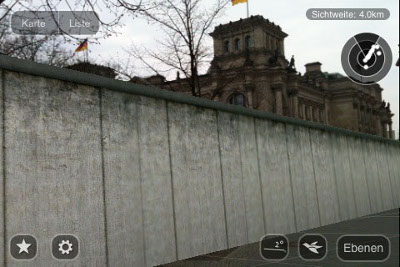
Figure 5: Berlin Wall layer
Conceived as a writing space, McLuhan’s notion of global theater resonates precisely with Sigmund Freud’s observations about a somewhat new technology in his era called the “Mystic Writing Pad.” Freud, who preceded McLuhan in treating recording technologies as extensions of human capacities, saw the Mystic Pad as a solution to a material problem that had long plagued writing technologies (which he thought of as memory-aids). Whereas practically all prior surfaces for writing either retain permanent traces at the expense of being receptive to future traces (e.g., stone) or receive unlimited traces at the expense of preserving any traces permanently (e.g., chalkboard), the Mystic Pad “provide[s] an ever-ready receptive surface and permanent traces of the notes that have been made upon it,” which conveniently approximates Freud’s model of “the structure of the perceptive apparatus of the mind” (209-10). Derrida’s commentary on Freud’s essay also presents fruitful grounds for thinking about the concept of global theater in terms of a writing space. For Derrida, “the depth of the Mystic Pad is simultaneously a depth without bottom, an infinite allusion, and a perfectly superficial exteriority;” more generally, the materiality of the Mystic Pad makes for an “unlimited envelopment of the present” and “the absolute absence of any foundation” (224). Of course, as Derrida notes, the Mystic Pad only did what Freud claimed it did in a very imperfect manner—the “permanent traces” it retained hardly ever retained their legibility. Because the global theater of mobile world browsers actually does create a writing space that is simultaneously receptive, permanent, and legible, its value can be more than just that of an analogy for theorizing something else (the psychical interplay of perception and memory in Freud’s case).
Both Freud and Derrida’s insights concerning the Mystic Pad can actually be engaged on a practical level to understand the situations of writing unfolding by virtue of world browsers. For example, historical events and prior circumstances can retain their legibility, remaining visible and spatially situated long after every material trace of their occurrence has vanished.5 Now any place—not just government sanctioned ones—can become digitally saturated with media content to the extent that it may function as a proportionate replica, historical reenactment, or monument.
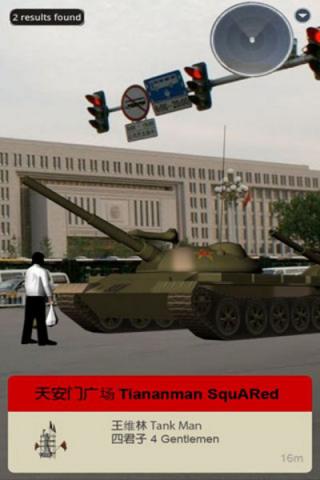
Figure 6: Tiananmen Square layer
The world’s surface is made to remember what happened upon it, to bear permanent, legible albeit virtual traces. And yet, functioning in Freud’s ideal image of the Mystic Pad, these permanent traces can be sorted through and effectively erased from the scene (without erasing them from the servers) and new permanent traces can be added at the scene, ad infinitum (or however much data the servers can hold). World browsers and the virtual-actual compositions (i.e., layers) that they host collectively stage an unlimited envelopment of the present, but an envelopment in which no layer can lay claim to or act as a universal, stable foundation. If someone navigates from your layer to another layer, your layer vanishes from their visual field; if someone never downloads the app that host your layer, your layer will probably never breech their consciousness. That does not mean, however, that a person without a smartphone could not be implicated as an actor in a layer and the history it mobilizes.
One can be held under the surveillance of history, such that one’s activity is seen and judged in immediate relation to the situated visualizations of particular histories. Though none of the above screen shots really dramatize this circumstance, we can easily imagine its possibility, and perhaps this imagining would yield extremely interesting projects—be they the work of professional new media artists or the classroom assignments of writing pedagogies to come. Writing founds memory, and technologies of cultural archiving condition the possibility for the collective memory we call history. World browsing is already initiating changes in the presentation of cultural archives6 that will have changed the way we build, exhibit, and experience histories.
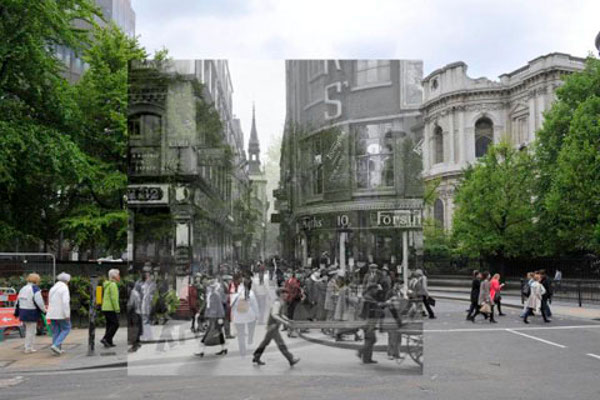
Figure 7: Museum of London’s app called “Streetmuseum”
Conclusion: Writing Pedagogies, World Browsers, Global Theater
Though pedagogy has not been my primary concern here, I do hope that my theoretical exploration of this emerging medium incites some productive questions about how one might engage it in the context of composition and/or media studies courses. In observing current trends in popular computing, we need to acknowledge smartphones, tablets, and mobile apps as serious writing technologies—important platforms for emerging visual and digital rhetorics—that can be complimentary to but also different from the Web-based platforms that much of our pedagogies have only recently begun to accommodate. Without specifically mentioning world browsers, Weisser testifies to the importance of mobile apps for the future of technical writing: “Many of our students will go on to careers in which they will use or perhaps create apps for portable devices, and we are obligated to prepare them for those careers” (“Mobile Apps”). In the infographic below, I suggest seven possible world browsing projects relevant to a sample list of rhetoric and writing courses, ranging from those with pre-professional agendas to others resolutely anchored in the traditional learning goals of liberal education.
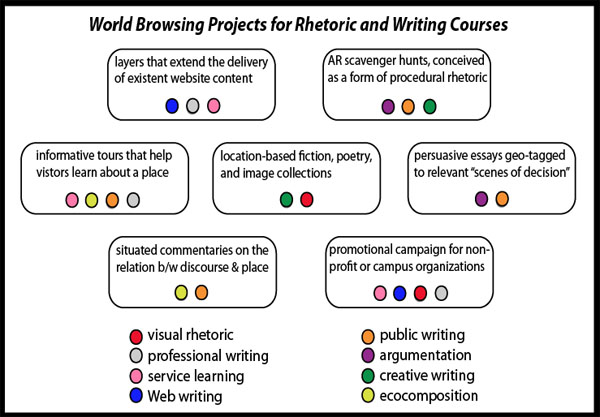
Figure 8: basic ideas for relevant world browsing projects
Undoubtedly, as the technologies of world browsing become more ubiquitous, “born-mobile” pedagogies will be invented and developed. I see the remediation of existing Web writing pedagogies as a crucial first step in that direction. As McLuhan so often pointed out, it is almost historically inevitable that the stuff of the prior medium comes to serve as the content of an emerging medium, at least in its early adaption. While I lack the space here to elaborate on how various established writing pedagogies could be enhanced, reversed, obsolesced, or retrieved through incorporating mobile world browsing, I will conclude by offering a short explication of how world browsing stands to enhance the assignment at the core of Gregory Ulmer’s Electronic Monuments—the MEmorial.
In short, the basic pedagogical objective of Ulmer’s MEmorial project is to commemorate (or perform an aesthetic testimony on behalf of) a disaster by monumentalizing that disaster through electronic means, eventually presenting this electronic monument as a website or as a peripheral at the physical site of an existing monument. More generally, Ulmer designed the project in hopes of cultivating the Internet as a civic sphere, wherein students (and other “egents”) can offer consultations on and possibly intervene in the production of group subjectivity and the formation of public policy discourse (xvii). In terms of these interventionist aims, world browsers are the platform that MEmorials have been waiting for, and I hope the reasons for this seem obvious by now. World browsers condition a translucent writing space that mixes layers of digital imaging/writing with lived perception of physical location; MEmorials, via world browsing, can freely (in every sense of the word) inhabit rather than simulate the places or monuments they target, and this turns the hypothetical/ideal aim of the project—a peripheral that actually intervenes—into a very feasible option for many students to pursue. The emergence of world browsing therefore enables, at least in principle, the MEmorial to become not only one of the most exciting and innovative pedagogical projects, but also widespread and of significant social impact.
Within the past year, an international artist collective call Manifest.AR, which includes John Craig Freeman (who has collaborated extensively with Ulmer), have already started to realize the potential of building electronic monuments with world browsing platforms.
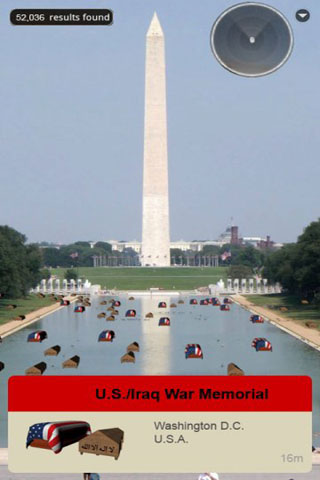
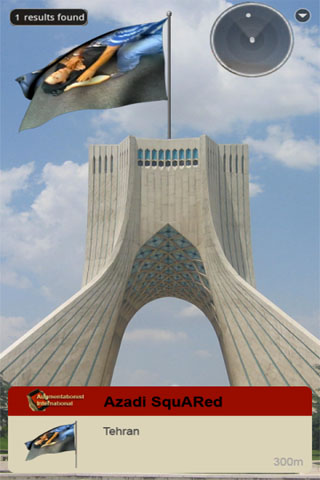
Figures 9-10: electronic monuments by John Craig Freeman
I include Freeman’s layers here not to offer any hermeneutic interpretation of them, but merely to indicate how they realize Ulmer’s MEmorial project and how they further some of the political/pedagogical ambitions on the horizon of Ulmer’s vision for electracy. Each of Freeman’s layers offer an exciting glimpse of what could become a thriving visual-electrate civic sphere, wherein digital rhetors contribute to public discourse on civil issues in a style that embodies the image metaphysics underlying the transition from literacy into electracy. Indeed, from the vantage point of computers and writing pedagogy, such may be the ultimate value of Freeman’s work. Obviously we cannot expect our students’ contributions to display the same level of technical and aesthetic sophistication as an internationally acclaimed artist, but student layers could nonetheless contribute in significant ways. In fact, by virtue of situating their work in public locations and by being among the early-adopters of world browsing, students who pursue projects on these platforms may very well achieve a level of public impact far beyond that of more typical Web or print assignments. In geotagging layers at the actual, geographic location of a given place, one’s writing/imaging about that place can become a critical element that shapes people’s immediate, lived experience of that place. And, just as importantly, the addition of any layer does not physically alter that concrete materiality of the place (unlike chalk or graphite); thus, the (f)act of layering can be situated in a place without physically changing or even defacing the place’s material makeup. The electrate civic sphere will—and perhaps can only—take place in the unique technological-ontological conditions of global theater.
Ultimately, the intellectual and pedagogical payoff of McLuhan’s notion of global theater resounds both in its continued relevancy as a framework to conceptualize electronic writing spaces and in the rich vocabulary it supplies. The omnipresence of performance and surveillance that McLuhan associated with the birth of satellites and the mediums they spawned is becoming further intensified and enhanced in the scenes of mobile world browsing. This new global theater, however, does initiate its own slurry of media effects that are different from the underlying conditions of the global theater of teleconferencing, for example. As this essay has shown, we are dealing with a unique space and scene of writing in the case of world browsing. Here, the spectators who have become actors now share the stage with vibrant, animate, location-based media. Text, image, and sound are made to move or hide in response to dynamic variables in the lived environment; places and objects are made to remember. All the world’s a link: human perception becomes linked to the Internet, media files become linked to exact coordinates on the world’s surface, and classroom assignments can become linked to actual, physical places beyond the campus and beyond the strictly computational spaces of the Web.
Notes
1 These early (and ongoing) efforts to engage mobile world browsers on behalf of the Occupy movement are documented on the Web.
2 That artists are pioneering much of the early innovative work with world browsing platforms should come as no surprise, especially if we note McLuhan’s observation that “it’s always been the artist who perceives the alterations in man caused by a new medium, who recognizes that the future is the present, and uses his work to prepare the ground for it” (“Playboy Interview”).
3 After qualifying memory as a form of unconscious, psychical writing, Derrida suggests, “Writing supplements perception before perception even appears to itself [is conscious of itself]” (Derrida 224).
4 See the following webpage for a demonstration and tutorial on how to engage these new, object-oriented features of the Layar AR platform.
5 As such, world browsers are extremely capable of supporting collective transference at the level of the group subject; abstracted from the psychoanalytic relationship between analyst and analysand, transference “refers to any experience from the past reactivated in the present” (Ulmer 61).
6 Cultural institutions such as the Museum of London and City of Philadelphia Department of Records have created large-scale world browsing projects that effectively put their photo archives on display across this city, by geotagging each historical photo in its initial spatial context amongst the contemporary urban environment.
Works Cited
Anderson, Chris and Michael Wolff. “The Web is Dead. Long Live the Internet.” Wired Magazine, 17 August 2010. 9 December 2011. Web.
Barry, Ann Marie Seward. Visual Intelligence: Perception, Image, and Manipulation in Visual Communication. Albany: State U of New York P, 1997. Print.
Baudrillard, Jean. Fatal Strategies. Trans. Philippe Beitchman and W. G. J. Niesluchowski. Los Angelas: Semiotext(e), 2008. Print.
Burnett, Ron. How Images Think. Cambridge, MA: MIT Press, 2004. Print.
Crowely, Sharon. A Teacher’s Introduction to Deconstruction. Urbana: NCTE, 1990. Print.
Derrida, Jacques. “Freud and the Scene of Writing.” Writing and Difference. Trans. Alan Bass. Chicago: Chicago UP, 1978. Print.
Edbauer Rice, Jenny. “Overhearing: The Intimate Life of Cell Phones.” Small Tech: The Culture of Digital Tools. Eds. Byron Hawk, David M. Rieder, and Ollie O. Oviedo. Minneapolis: Minnesota UP, 2008. Print.
Freud, Sigmund. “A Note upon the ‘Mystic Writing Pad.’” General Psychological Theory. New York: Touchstone, 1997. Print.
Levinson, Paul. New New Media. New York: Allyn & Bacon, 2009. Print.
McLuhan, Marshall. “At the Moment of Sputnik the Planet became a Global Theater in which there are no Spectators but only Actors.” Journal of Communication, 24.1 (1974): 48-58. Print.
____. “From: The Playboy Interview: Marshall McLuhan." The Marshall McLuhan Center on Global Communications. Playboy, December 2008. 20 August 2011. Web.
____. Understanding Me: Lectures and Interviews. Eds. S. McLuhan and D. Staines. Cambridge: The MIT Press, 2003. Print.
____. Understanding Media: The Extensions of Man. London: Routledge & Kegan Paul, 1964. Print.
McLuhan, Marshall with Wilfred Watson. From Cliché to Archetype. New York: Viking, 1970. Print.
Pedersen, Isabel. “Dehumanization, Rhetoric, and the Design of Wearable Augmented Reality Interfaces.” Small Tech: The Culture of Digital Tools. Eds. Byron Hawk, David M. Rieder, and Ollie O. Oviedo. Minneapolis: Minnesota UP, 2008. Print.
Reynolds, Nedra. Geographies of Writing: Inhabiting Places and Encountering Difference. Carbondale, Southern Illinois UP, 2004. Print.
Ulmer, Gregory. Electronic Monuments. Minneapolis: Minnesota UP, 2005. Print.
Vallino, James. "Introduction to Augmented Reality." Augmented Reality. 22 August 2002. 10 April 2011. Web.
Weisser, Christian. “Mobile Apps and the Tech Writing Curriculum.” The Digital Ink. 10 Sept. 2011. Web.
____. Moving Beyond Academic Discourse: Composition Studies and the Public Sphere. Carbondale, Southern Illinois UP, 2002. Print.
Video Credits
"Argon: Augmented Reality Browser."?AELatGT. YouTube.com. 7 Oct. 2010. Web. 20 Feb. 2011. http://www.youtube.com/watch?v=F_M8C2jW8PI.
"CNN: Tech: 'Augmented' reality on cell phone." CNN. YouTube.com. 29 Sep. 2010. Web. 25 Feb. 2011. http://www.youtube.com/watch?v=oKgu9sMOuMA. ?
"cyclopedia new iphone geotag on-screen –app."?stuttgarclubtzapata. YouTube.com. 4 Oct. 2009. Web. 18 Feb. 2011. http://www.youtube.com/watch?v=3Cv6cJA2Wg.
"Gagosian Gallery Anselm Kiefer Infestation."?willpap. YouTube.com. 1 Mar. 2011. Web. 7 May 2011. http://www.youtube.com/watch?v=QP7VAhac6Os.
“Images.” Manifest.AR. ManifestARblog.wordpress.com. 25 Jan. 2011. Web. 20 Mar. 2011. http://manifestarblog.wordpress.com/Images/.
"Mobile Augmented Reality - Cereal box."?metaioAR. YouTube.com. 20 Oct. 2009. Web. 2 May 2011. http://www.youtube.com/watch?v=b1naY762FHc.
"MoMA NYC augmented reality exhibition."?sndrv. YouTube.com. 26 Oct. 2010. Web. 24 Jan. 2011. http://www.youtube.com/watch?v=b9T2LVM7ynM.
"Streetmuseum." MrJackKerruish. YouTube.com. 1 Dec. 2010. Web. 12 Jan. 2011. http://www.youtube.com/watch?v=qSfATEZiUYo. ?
"Tagwhat Video: Expanded Version.” BonfireSocialMedia. YouTube.com. 20 Jul. 2010. Web. 29 Mar. 2011. http://www.youtube.com/watch?v=qi_eek1Jbdk.
"White Guide augmented reality restaurant locator."?Teknograd. YouTube.com. 27 Mar. 2010. Web. 2 May 2011. http://www.youtube.com/watch?v=ZhCwgkbfJgY.
"Wikitude.me."?Wikitude. YouTube.com. 28 Aug. 2009. Web. 10 Feb. 2011. http://www.youtube.com/watch?v=oBUboszb02o.
"Virtual landscapes: Boston Cyberarts Festival exhibit at the ICA." thebostonglobe. YouTube.com. 8 Apr. 2011. Web 27 Apr. 2011. http://www.youtube.com/watch?v=rEPNE47O1e0.